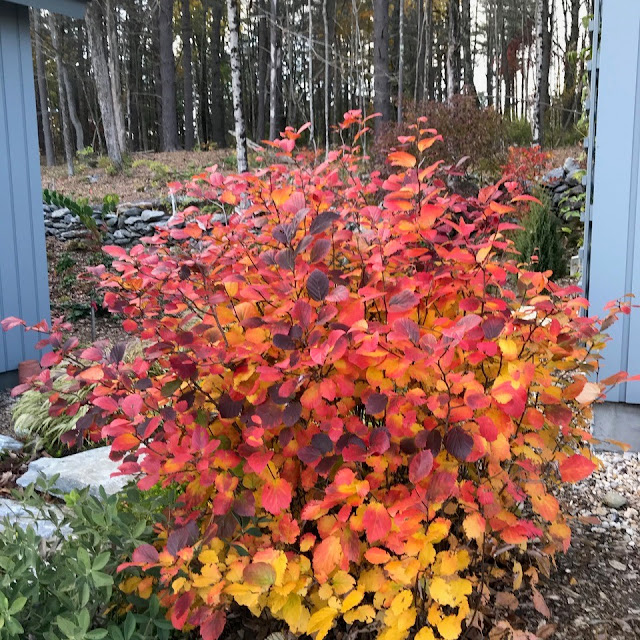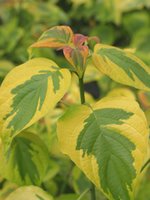I would have thought, off the top of my head, that there were a lot of shrub species that had fantastic fall color, but when I drove our trial fields searching, I was dismayed that only a limited number of species really stood out with bright autumn hues. Of course everyone thinks of burning bush as the quintessential fall color shrub, but there has to be more. What else is there to use?
With a bit of thought, I came up with a list of six outstanding shrubs that can add fantastic fall color to your landscape. They're in no particular order, but they're all excellent plants that are worthy of a place in your yard, nursery, or landscape design. Each has its own unique hue of fall foliage color, from blends of bright orange to bold purplish reds. And unlike Euonymus alatus, they're all North American natives.
1. LEGEND OF THE FALL® Fothergilla
Fothergilla has always been appreciated for its spectacular autumn color, but Legend of the Fall® fothergilla sets a new standard for the species with brilliant, glowing hues of orange, yellow, and red. Spring brings a crop of fragrant white flowers. This plant was also selected for its improved production performance, a boon since this plant will surely be in high demand by landscapers and garden designers.
USDA Zone 5-9 (-20°F/-28.9°C)
Exposure: Full sun, part sun
Height: 4 - 5'
Width: 4 - 5'
Bloom Time: Spring
Flower Color: White
2. LOW SCAPE MOUND® Aronia melanocarpa
As cute as a button yet tough as nails, Low Scape Mound® aronia is an innovative dwarf selection that may be the closest thing yet to a perfect landscape plant. Adaptable to most any soil, this versatile little black chokeberry offers dark, glossy foliage, loads of white flowers in spring, black summer fruit, and intense red foliage in autumn. Ideal for low-maintenance mass plantings; think of it as Rhus 'Gro Lo' with multi-season appeal. Developed by Dr. Mark Brand of the University of Connecticut. Low Scape Mound aronia is the 2019 Landscape Shrub of the Year. Winner of the Boskoop Royal Horticultural Society Silver Medal
USDA Zone 3-9 (-40°F/-40°C)
Exposure: Full sun, part sun
Height: 1 - 2'
Width: 2'
Bloom Time: Spring
Flower Color: White
3. KODIAK ORANGE® Diervilla
Another eco-friendly alternative to burning bush, Kodiak® Orange diervilla pushes fall color to the limits with its transformation to fire embers orange. In the spring and summer, new growth emerges, a showy russet-orange, which is accompanied by bright yellow flowers in summer. But late summer and fall are the real show when the entire shrub turns bright citrus orange. This easy-growing, vigorous North American native is unbothered by pests or diseases. Diervilla is one of the most adaptable landscape plants you can grow. You'll find it growing in dry shade on the shores of Lake Superior, south on the red clay soils of Georgia. Sometimes known as bush honeysuckle, which is just plain stupid as well as a misnomer, so just call it diervilla as the common name. Developed by Garden Genetics, Kodiak Orange won the Boskoop Royal Horticultural Society Silver Medal.
USDA Zone 4-7 (-30°F/-34°C)
Exposure: Full sun, part sun, shade
Height: 3 - 4'
Width: 3 - 4'
Bloom Time: Summer
Flower Color: Yellow
Foliage Color: Orange
4. SCENTLANDIA® Itea virginica
Fabulously fragrant. Sweetspire is beloved for so many reasons: it’s native, shade-tolerant, deer-resistant, has handsome foliage, amazing fall color, very showy flowers, and, of course, delicious fragrance. So how could Scentlandia® sweetspire improve on the classic? Better hardiness and better fragrance. It has the best fragrance of any Itea I've ever encountered. Year after year you'll get great fall color, along with a compact, refined habit. Winner of the Boskoop Royal Horticultural Society Silver Medal. I named it in honor of one of my favorite TV shows.
USDA Zone 5-9 (-20°F/-28.9°C)
Exposure: Full sun, part sun, shade
Height: 2 - 3'
Width: 2 - 3'
Bloom Time: Early summer
Flower Color: White
Foliage Color: Green
5. SKY DEW GOLD® Vaccinium corymbosum
Bright yellow foliage is the backdrop for tasty summer blueberries. Things get even more interesting as the summer nights start to cool and the golden foliage starts taking on rich hues of orange and red. The transformation is simply thrilling; seeing something so colorful and cheerful puts a smile on my face.
USDA Zone 4 - 8 (-30°F/-34.4°C)
Exposure: Full sun
Height: 2 - 4'
Width: 3 - 4'
Bloom Time: Late spring
Flower Color: White
Foliage Color: Chartreuse, Orange
6. GATSBY PINK® Hydrangea quercifolia
Just as The Great Gatsby is a classic of American literature, H. quercifolia is a classic North American native hydrangea. Long prized by savvy gardeners for its flowers and fall color, this sophisticated shrub deserves a wider market. Gatsby Pink is a remarkable oakleaf selection from Powell Gardens of Kingsville, MO. It boasts big, showy lacecap blooms that quickly transform from pure white to a delightful pink. The dark green foliage turns mahogany-red in autumn. It also reblooms a bit as well.
USDA Zone 5-9 (-20°F/-28.9°C)
Exposure: Full sun, part sun
Height: 6 - 8'
Width: 6 - 8'
Bloom Time: Summer
Flower Color: White, Pink
Foliage: Color: Green, burgundy
7. STAGHORN SUMAC Rhus typhyna

Ok, so I cheated and added a seventh shrub, but it is so worth it. Rhus typhina, the Staghorn sumac, is one of my favorite native shrubs because it is one of the first to change color. The plant has fuzzy stems (like a stag’s horn), great orange to deep red fall color, and attractive red seed heads. I learned this plant as a young boy when my dad taught me how to make staghorn lemonade with its fruit—look it up. It’s commonly found along highways, forming dense clumps. At 70 mph, it's easy to see that each clump differs genetically in size, fall color, and fruit. Unfortunately, as it is a suckering plant that moves around a bit, most gardeners don’t have the room for a clump in their garden. Still, it does deserve greater use. There are several excellent cultivars that are garden worthy; ‘Disecta,’ aka ‘Laciniata,’ is grown for its attractive lacy cut leaves. Tiger Eyes or ‘Bailtiger’, is a yellow leafed selection of ‘Disecta’. This plant has all the wonderful attributes of the species but with bright yellow leaves that give summer-long interest.








